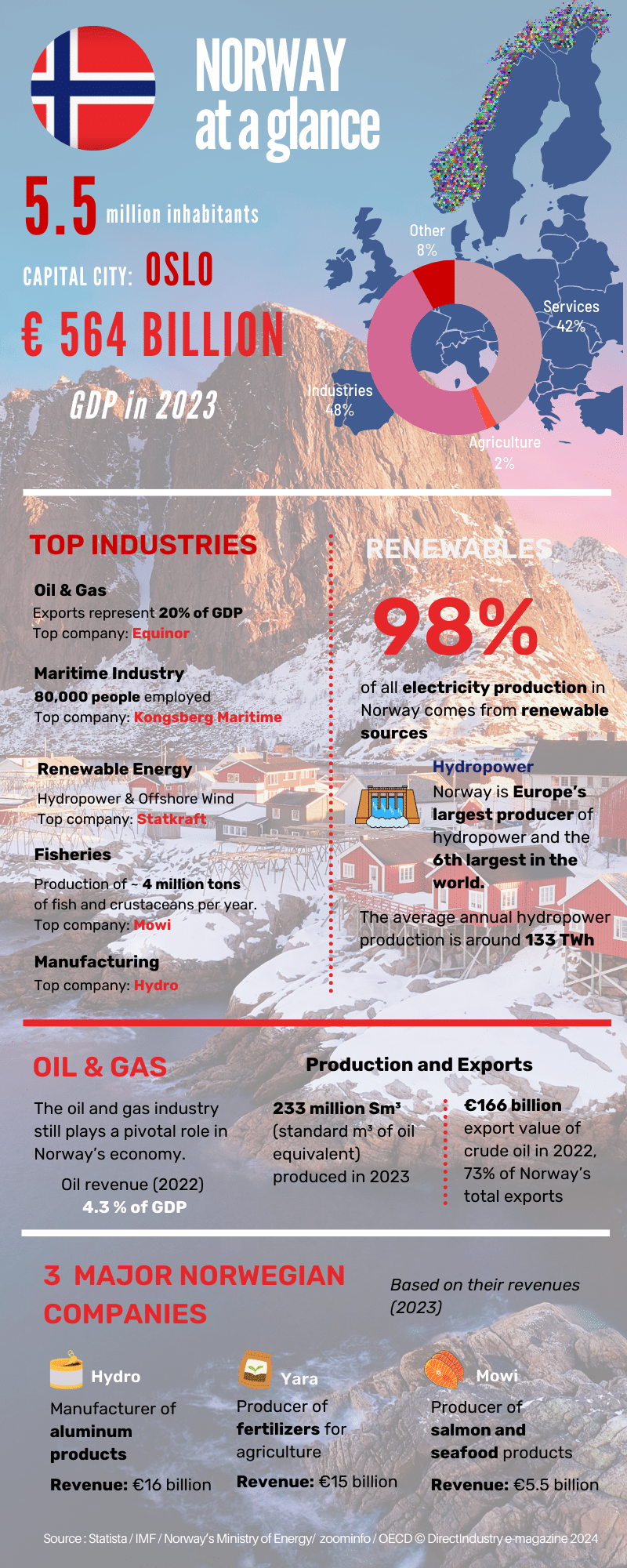Norway, with its breathtaking fjords and pristine landscapes, is more than just a picturesque travel destination. It boasts a robust economy and a diverse range of industries that contribute significantly to its prosperity. Norway is the partner country for this year’s edition of Hannover Messe. We have created an infographic featuring key figures about the country’s industries.
With a population of 5.53 million people, Norway has a GDP of €564 billion. This GDP is supported by three sectors: industry (48.69% of the GDP), services (42.15% of the GDP) and agriculture (1.55% of the GDP).
Norway is the fastest-growing Nordic country. It is a key supplier of energy to Europe and leads the world’s electric vehicle market.
According to Per Niederbach, Executive Vice President and Head of Trade & Invest, Innovation Norway
“Norway has a very rich industrial history. We are known as a reliable energy producer and a pioneer in sustainable solutions. Our heritage, combined with a competent workforce as well as a high degree of trust and stability, makes us an attractive partner in the green and digital transition and hopefully an attractive country for doing business.”
Norway: A Thriving Hub of Industries
What are the key industries in Norway and their contribution to the GDP? Here is some information.
1. Oil & Gas Sector
Norway is a major player in the global energy market, primarily due to its abundant oil and gas reserves. Since its inception, 123 fields on the Norwegian shelf have produced oil and gas. As of 2023, 92 fields remain in production.
The North Sea fields, including Troll, Ekofisk, and Snorre, continue to fuel Norway’s economic engine. Around 80 discoveries are being considered for development. The total length of the Norwegian gas pipeline network spans about 8,800 kilometers.
In 2023, Norway’s total production was about 233 million Sm³ o.e. (standard cubic meters of oil equivalent). Half of this volume comprises natural gas.
According to the International Monetary Fund (IMF), Norway’s oil revenue amounts to 4.3% of GDP — compared with 0.2% for the OECD as a whole.
The petroleum industry accounts for 46% of the country’s export revenues. The export value of crude oil, natural gas, and condensate in 2022 reached 1,900 billion NOK (€165 billion).
The sector employed approximately 200,000 people in 2021.
2. Renewable Energy
Norway is an oil country but is also a large producer of renewable energy.
Hydropower
Norway is Europe’s largest producer of hydropower and the 6th largest in the world. 98% of electricity production in mainland Norway comes from 31 GW hydropower plants with an 86 TWh reservoir capacity. The average annual hydropower production is around 133 TWh.
Solar Energy
Norway has limited solar energy resources but, it is one of the world’s largest producers of solar-grade silicon and silicon solar cells.
Wind Power
Wind power currently contributes a small fraction of total production, but Norway has ambitious plans to expand it. Norway is for example aiming at rethinking and repurposing its business based on oil, says Per Niederbach, Innovation Norway,
“Norway is devaluing its offshore industry to become a significant player in floating offshore wind and is already the largest floating offshore wind player following the development of something called high wind tampon in the North Sea, which now is the world’s largest floating wind park.”
Hydrogen
Norway plays an important role in ensuring energy security by supplying natural gas to Europe. But it is now aiming to supply low-carbon and renewable hydrogen.
According to HE Laila Stenseng, Norway’s ambassador in Germany whom we met at Hannover Messe Press Preview last February,
“Norway contributes through innovations such as electrolysis-produced aluminum. We will present these innovations and many others at the Hannover Messe as an example of our commitment to a sustainable future and the continued development and safeguarding of Norwegian industry and jobs.”
3. Manufacturing Industry
Norway’s manufacturing industry has witnessed steady growth over the past two decades, expanding by 270% in exports. Key products include machinery, transport equipment, and high-quality maritime technology.
Approximately 30% of Norway’s export revenues come from manufacturing. The contribution of manufacturing to GDP is 4,7632 % in 2022.
4. Maritime Industry
Norway has a long maritime tradition and is a prominent ship-owning nation, hosting important maritime events like Nor-shipping. The value creation of the sector for 2021 is around NOK 154 billion (€13 billion). The industry employs over 90,000 people.
Norway’s maritime industry is now shifting to sustainability. With the MF Hydra project, Norwegian companies joined forces to design, build, and equip the world’s first ferry to run on liquid hydrogen.
5. Fisheries
Norway is very famous for its salmon and seafood. The fishing industry plays an important role in the country’s economy.
According to OECD, in 2018, Norway produced 4 million tonnes of fish (including mollusks and crustaceans), with a value of €9.9 billion. 77% of this value came from aquaculture and 23% from fisheries.









![Image [Best of 2025] Power Moves in the Energy World](/wp-content/uploads/sites/3/energy-320x213.jpg)
![Image [Best of 2025] How Generative AI Is Transforming Industry](/wp-content/uploads/sites/3/AI-4-320x213.jpg)
![Image [BUYING GUIDE] How to Choose the Right Industrial Robot?](/wp-content/uploads/sites/3/Industrial-Robot-320x213.jpg)
